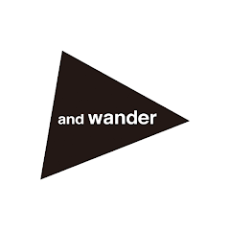2020.09.18
"EVERYBODY NEEDS A ROCK 2020"
An interview with Sae Hondaand wander journal #16
9/18(金)から10/18(日)まで、「and wander OUTDOOR GALLERY with PAPERSKY」にて、ジュエリー作家・本多沙映さんの展示『EVERYBODY NEEDS A ROCK 2020』が開催される。and wander 2020AW のアイテムでもコラボレーションを展開している本多さんに、作品にまつわる話をきいた。
“EVERYBODY NEEDS A ROCK 2020”, an exhibition of work created by jewelry designer, Sae Honda, will be held from Friday September 18 to Sunday October 18, at the and wander OUTDOOR GALLERY with PAPERSKY. Sae is also collaborating on and wander’s 2020 AW items. During this interview we will be hearing from her about her work.
『EVERYBODY NEEDS A ROCK 2020』開催
本多沙映さんインタビュー
オランダ南部・アイントホーフェンという小さな町に暮らす、ジュエリー作家の本多沙映さん。アーティストが多く暮らし、制作に集中できる環境が整っていたことから、本多さんはここにアトリエを構えたという。
そんな本多さんの活動を振り返ると、ジュエリー作家とはいうものの、いわゆる宝石や貴金属といったジュエリーを扱う作品を手がけているわけではない。彼女にとって、ジュエリーとは何か。美しいものとは何か。“EVERYBODY NEEDS A ROCK”の制作秘話をインタビュー。
―これまでの本多さんの作品を拝見すると、身につけられるものは少ないですし、これもジュエリーなのだろうかと頭をひねってしまう難解な作品もあります。はじめに、本多さんの考えるジュエリーの定義を聞かせてください。
「オランダは以前から、価値のない素材も自由に使った表現のためのジュエリー、いわゆるコンテンポラリー・ジュエリーという分野で先端をいっている国でした。そのため、コンテンポラリー・ジュエリーのギャラリーがあるし、アーティストも多いんです。私は宝石も好きですが、一方でキッチュなプラスチックに価値を見出すことにも興味をひかれるので、同じ土俵でみんなが価値を見出してくれるものをつくれたらいいなと思って、コンテンポラリー・ジュエリーを学ぶためにオランダへやってきました。だから、定義といえるかはわかりませんが、つくっている人がどれだけその存在やものに価値を見いだせるか、また、それを身に着けてもらう人にシェアできるか、ということでしょうか」
Jewelry designer, Sae Honda, lives in Eindhoven, a town in southern Netherlands. Sae chose it as the location for her atelier for its artistic community and for its environment, one that she finds enables her to concentrate on her creative work.
Although a jewelry designer, Sae does not use conventional precious stones or metals. What does “jewelry” signify to her? What is beauty? This interview will delve into the secret story behind the creation of “EVERYBODY NEEDS A ROCK”.
- Looking at your work, I notice that there are few items that can actually be worn, and some intriguing works that make me question if they are actually jewelry. So, to start off, could you tell me how you define “jewelry”.
“The Netherlands, as a country, has been at the forefront of “contemporary jewelry” or what is known as expressive jewelry. This is jewelry as a form of expression, that purposely uses materials that have no innate value. That’s why you will find many contemporary jewelry galleries and artists in the Netherlands. I do like precious stones, but I’m also interested in creating value from kitsch plastic, and I wanted to create items that people would value in the same way, so I came to the Netherlands to study contemporary jewelry. So, I’m not sure if you can call it a definition, but I think it’s about how much value the creator can discover in an object or its presence. And it’s also about how much the creator can share this with the person who will wear it.
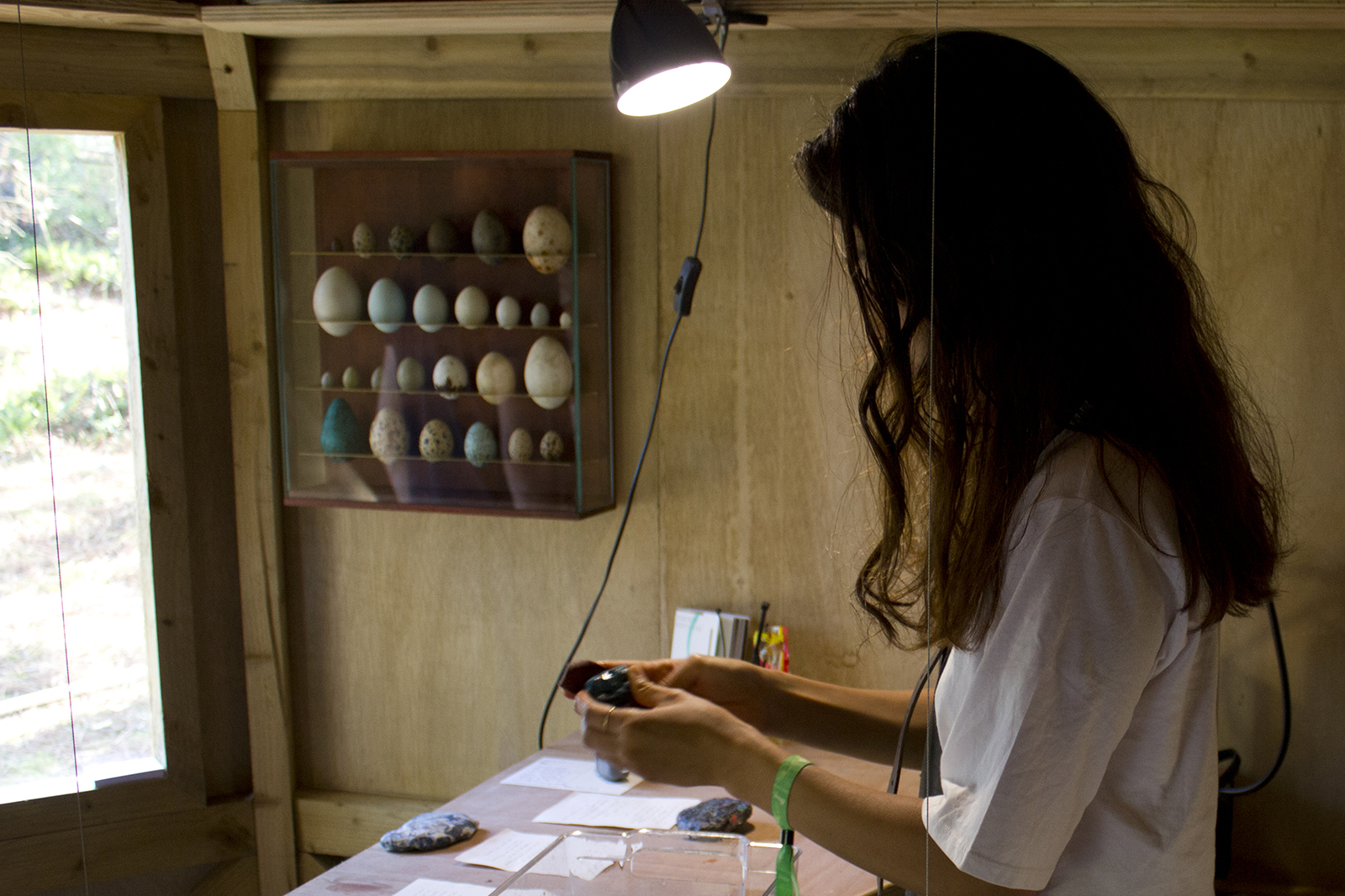
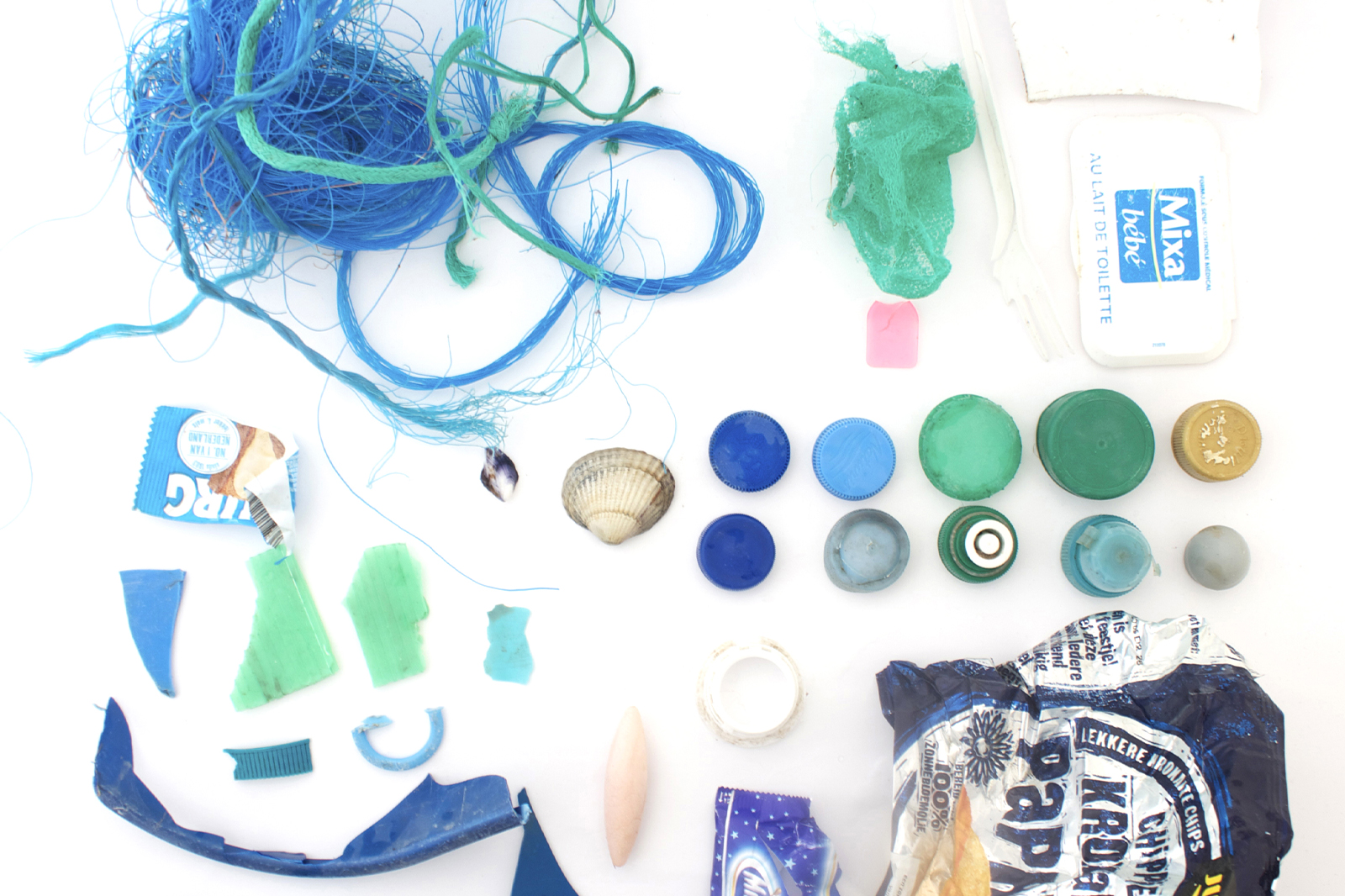
―たしかに私たちは、ダイヤモンドやゴールドが価値の高いものだという既成概念にとらわれしまっているかもしれません。今回「and wander OUTDOOR GALLERY with PAPERSKY」にお目見えする“EVERYBODY NEEDS A ROCK ”は、プラスチックごみに特殊加工をして、美しい石として蘇らせた作品です。オランダはデザイン大国ですが、環境問題への意識が高く、エコ先進国ともいわれます。そのような背景も影響しているのでしょうか。
「オランダでは環境問題や社会問題などをテーマに扱うデザイナーさんも多いですし、アップサイクルのアイデアが浸透していたり、毎年世界の動きに反応したトピックが出てきますね。私自身は、ものや素材の価値の見出し方に興味があってこの世界に飛び込んだので、環境問題への興味からはじまったプロジェクトではありませんが、コンテンポラリー・ジュエリーを学んだことで、少なからず影響を受けているとは思います」
- Yes, I think you’re right that we are, in a way, caught up in the preconceived idea that diamonds and gold have “value” in themselves. The “EVERYBODY NEEDS A ROCK” exhibition, that’s debuting at and wander OUTDOOR GALLERY with PAPERSKY, is a collection of beautiful stones that have been reborn out of plastic waste that has undergone a unique transformation process. The Netherlands is not only known as a leading country in the area of design, but it is also known for its environmental progressiveness. Has this also influenced your work?
“There are many designers in the Netherlands whose work examines environmental or social themes. The idea of upcycling is prevalent and you see new ideas emerging all the time, in response to what is going on in the world. Me personally, I entered this domain from an interest in how I can create value in items or materials, so environmental issues weren’t part of my original motivation for the project. However, since studying contemporary jewelry I think I’ve been very much influenced by this perspective.”
―制作過程を記録した動画では、森に囲まれた、気持ちのよさそうな場所でつくられていますね。ここはアトリエの近くなのでしょうか?
「いえ、ここはフリーランドというオランダ北部の小さな島です。毎年夏にInto The Great Wide Openという野外の音楽フェスティバルが開催されるですが、そこでアートを展示するイベントがあり、それに招聘されたときのものです。4日間ほどの滞在中にごみを集めて、お客さんの前で制作過程を見せながら石をつくったんですよ」
―プラスチックごみは、数千年後も残るといわれる、現代の悩ましい環境問題のひとつです。それを石(ジュエリー)として、新たに生まれ変わらせるアイデアはどのようなところから生まれたのでしょうか。
「数年前に、プラスチックごみが自然物に溶けてまざった石がハワイで見つかったという記事を読んでからですね。実際にその石がきれいだったというわけではありませんが、こういうことが未来では当たり前に起こって、ルビーなどの鉱石みたいに希少価値のあるものとして扱われるのかもしれないと想像したらおもしろいなと感じました。それでプラチックを溶かしたりいろいろ試してみると、きれいな石ができはじめたんです」
- In this video of you working, you’re surrounded by trees, in what looks like a very serene place. Is this near your atelier?
“No this is actually on a small island in the north of the Netherlands called Vlieland. Every summer a music festival called 'Into the Great Wide Open' is held there and I was invited to exhibit my work as part of the festival. I collected pieces of plastic waste over the 4 days or so that I was there, and then I showed people how I created stones from the waste as I worked.”
- It is said that plastic waste will remain on the planet for thousands of years, and is one of the most worrying environmental issues of our time. Where did you get the idea to give waste a second life by making it into stones (jewelry)?
“It was after reading an article a few years ago about a stone that was found in Hawaii. It contained some plastic that had naturally melted and been mixed into the stone. The stone itself wasn’t particularly beautiful, but I found it interesting to imagine a time in the future when this might be commonplace, and such stones are considered valuable because of their rarity, like minerals such as rubies. So, I tried melting plastic and other techniques and found that I could create quite beautiful stones.”
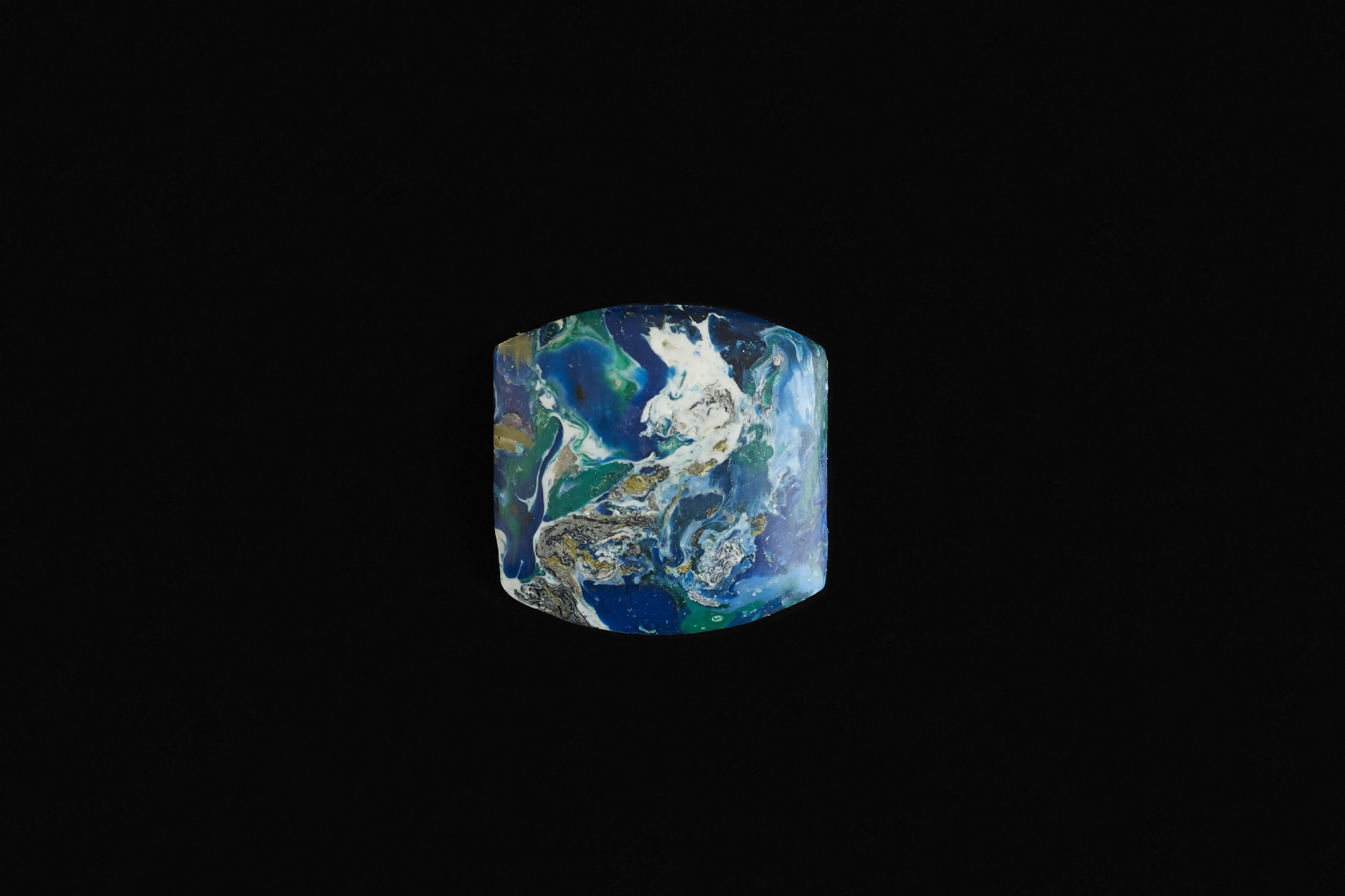
―何からできているかはさておき、純粋に美しい石だと感じます。廃棄物のこの色と素材を組み合わせたら、こんな石ができるだろうなぁ、などとイメージはできるものなのでしょうか?
「そうですね。徐々にマスターしてきたので、今では道を歩いていると、“あ、このごみはきれいになる!”と立ち止まったりすることもあります(笑)」
―展示のメインビジュアルにもなっている石は、昨年、本多さんが一時帰国中にand wanderの事務所を訪れ、そのときに集めた廃棄物からつくられたものだそうですね。
「デザイナー森さんが長らく使っていたものさしなんかも入っていますね。写真では見えませんが、石の裏側にYKKのジッパーの文字が出てきているのが、ちょっとユニークで気に入っているポイントです」
- Putting aside what they are made from, I find that they are beautiful in themselves. Are you able to imagine what sort of stone you’ll be able to create from the different colours of different pieces of waste?
“Yes, maybe I can. Over time I’ve become better at it, so now when I’m walking down the street, sometimes I find myself thinking 'Oh! That could be beautiful’ and stopping when I find a piece of plastic waste.”
- The center piece of the exhibition is a stone created from waste that you collected when you visited the and wander office, when you were back in Japan last year, right?
“Yes. It contains a ruler that the designer Mori used for many years. You can’t see it in the photo but, on the back of the stone, you can also see the letters YKK from a zipper, and this is one unique element of the stone that I’m fond off too.”
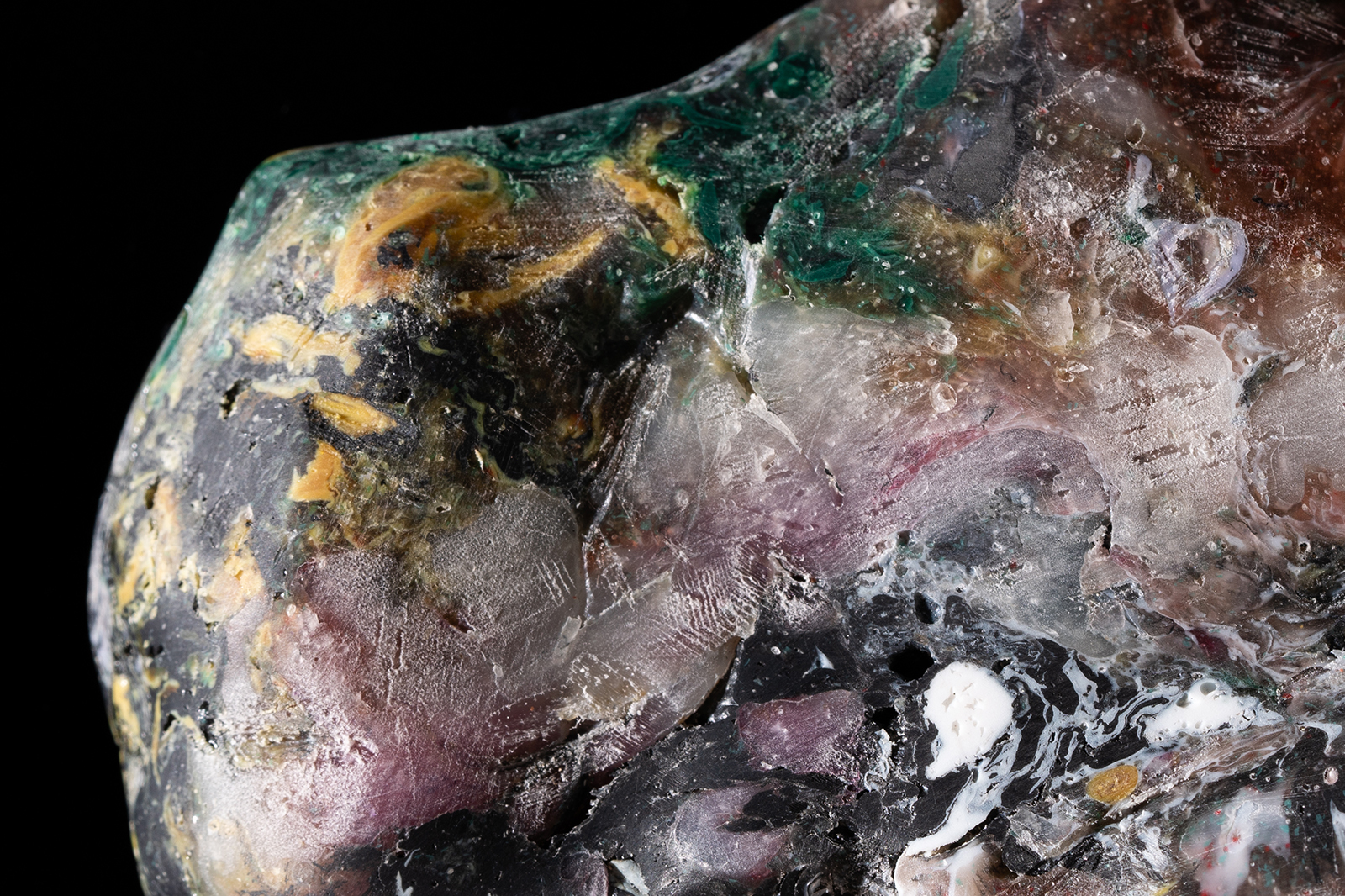
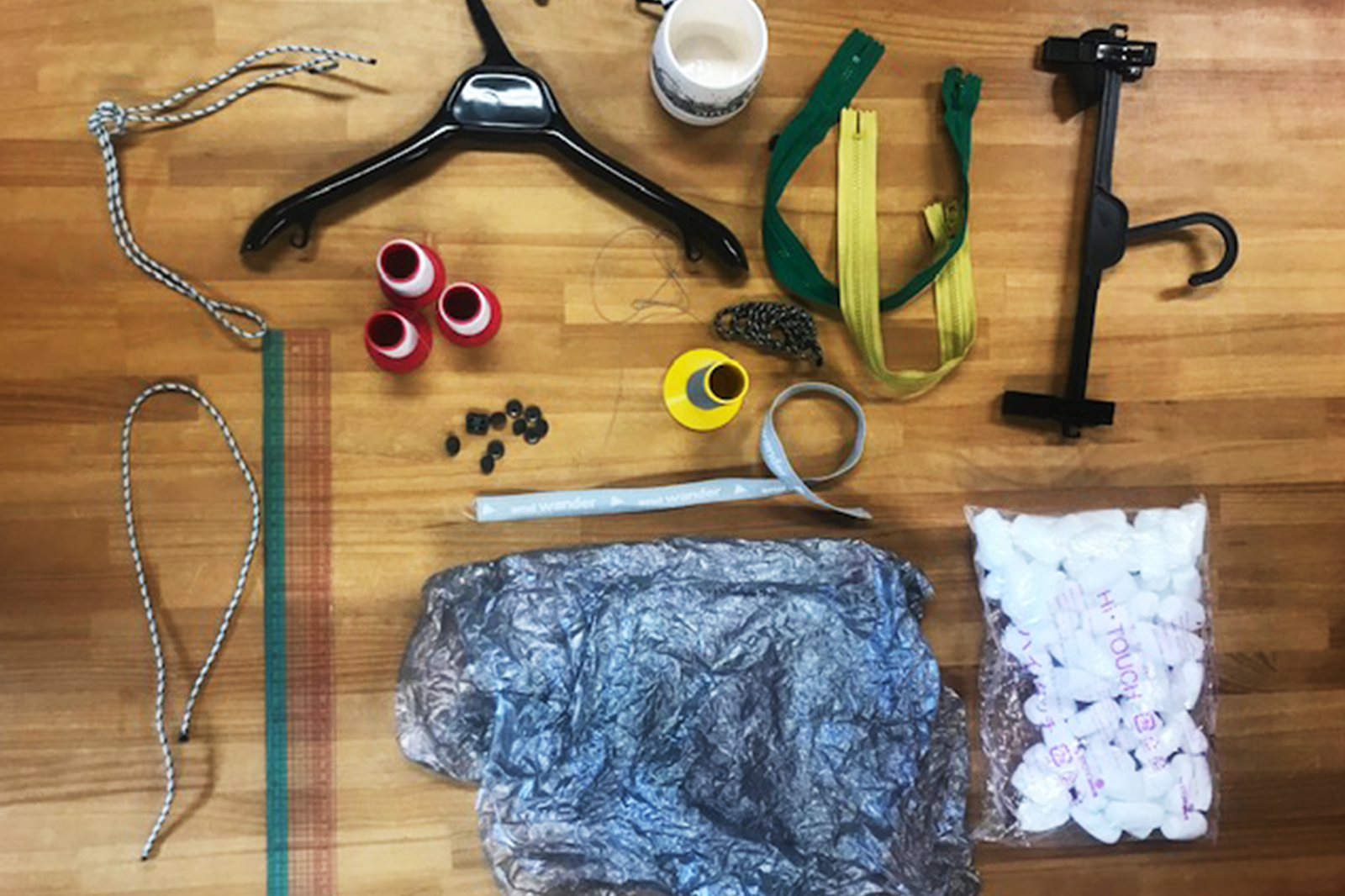
―〈SPACE RUNNER〉という名前の作品が、モチーフとしてand wanderの20AW のアイテムにも採用されていますね。実際にウエアになったのをご覧になっていかがでしたか?
「惑星っぽくてかっこいいですね。もともと黒バックで石を撮ると宇宙のようで好きだという話をしていたのですが、それが表現されていてうれしいです。光沢感のある再生ポリに印刷された質感も新鮮だし、いくつもつなげて柄になっているのもおもしろい」
and wander OUTDOOR GALLERY with PAPERSKYの詳細はこちら
- Your creation〈SPACE RUNNER〉has been chosen to be used as a motif for and wander's 20AW items. What did you think when you saw it on the actual wear?
“It looks great, it almost looks like planets. I talked about how I like to take pictures of my stones in front of a black background because it creates images that look like they’re from outer space, so I was very happy to see this cosmic feel being expressed. It’s also refreshing to see the pattern printed on recycled polyester, which has a glossy feel to it, and it was fascinating to see the image repeated and connected together into a single pattern.
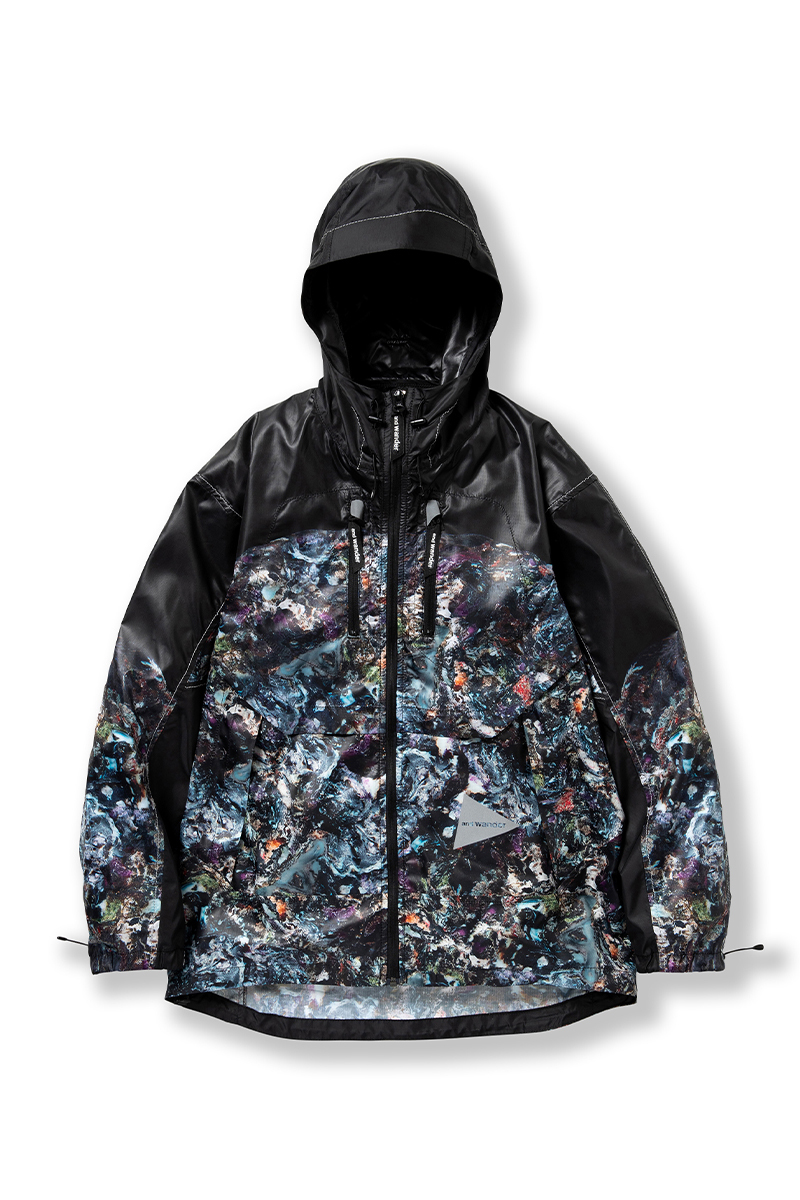
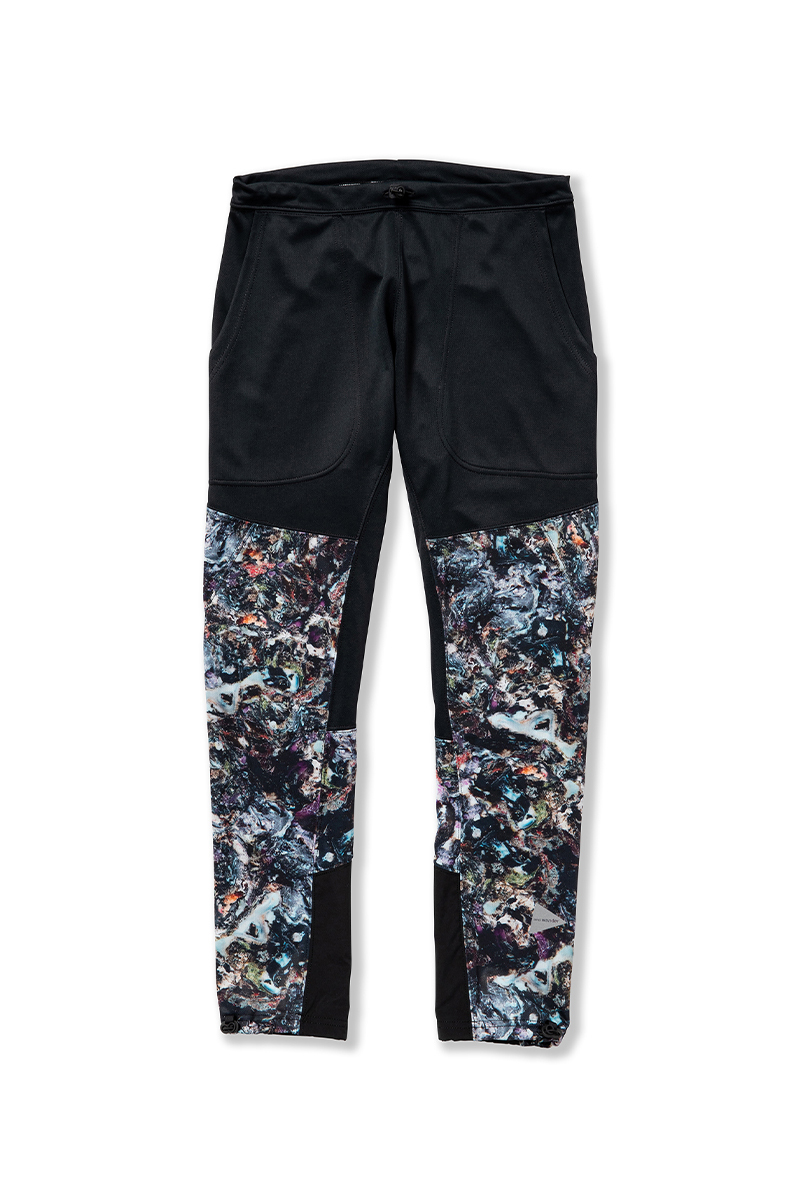
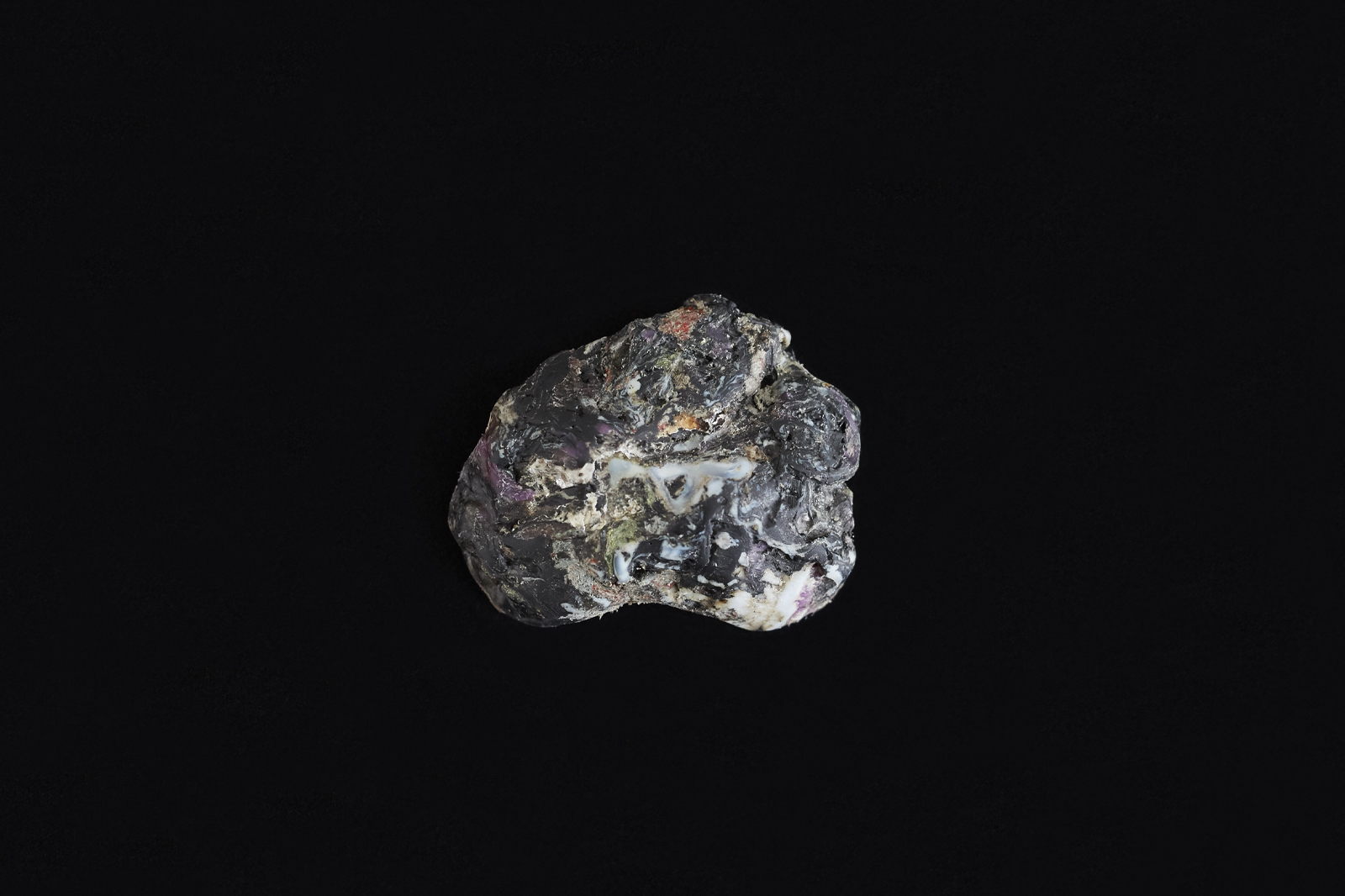
―今ではごみの素材や色の組み合わせから完成をイメージできるということですが、ひとつの石をつくるのに、ルールはありますか?
「できるだけ自然のシステムに近づけて、隣り合ったもの同士が徐々に一緒になるイメージで、ひとつの石は半径5mくらいのところから出たごみの組み合わせでつくっています。その場所のGPSコードを記録して、石の鑑定書のようなものをつけているのですが、そこにGPSコードを記載しています」
―最後に今回展示・販売される作品についてお聞かせください。標本箱に入った額入りが8点、小さな石が17点。オランダを中心に、日本やドイツの廃棄物でつくられたものだそうですね。〈Saskia〉〈Thread island〉〈Purple River〉といった作品名は、どのようにつけられたのでしょうか。
「石の中に入っている袋のお菓子の名前の場合もあるし、できあがった模様を見て連想した言葉や、ごみを採った場所の名前だったり、ランダムにつけられています」
―なるほど、〈Thread island〉は福岡・糸島産なのですね!最後に、(すべてに思い入れがあるとは思いますが)とくにお気に入りの作品をひとつ挙げるとすればどれか教えてください。
「一番大きな“Silver spoon”という作品です。フリーランド島の滞在時につくったものなのですが、海辺で採集したので、漁業用ロープや砂が入っています。海で採ったものって青や緑が入って、不思議なことに地球っぽくなるんですよね。砂もキラキラしているので、特別な感じが際立って気に入ってます。こんな天気の日にこのごみを採ったなぁ、とか、ひとつひとつの石に自分なりの思い出が付着して、情景なんかも浮かび上がってきます。すべて好きな作品です(笑)」
―〈SPACE RUNNER〉の実物の石も展示されるとのことで、and wanderのアイテムとを見比べてみるのも楽しそうです。今日はありがとうございました!
- You said that now you are able to imagine what your finished creation will look like when you look at combinations of materials and colors, but are there any rules when you create a stone?
“I try and stay as close to the natural system as possible, so gradually bringing together items that were next to each other. I use waste materials that were all found within a radius of 5 meters for each individual stone. I record the GPS code from that location, and I make a sort of “certificate of authenticity” for the stone, on which I include the GPS code.
- And finally, could you tell us about the items on display and for sale at the event. There are eight that are framed and in boxes, and 17 smaller stones. They are made from waste items collected mainly in the Netherlands, but also Japan and Germany. Could you tell us about the origins of their names such as 〈Saskia〉〈Thread Island〉 and 〈Purple River〉?
“I name them randomly - it might be from the name of a snack wrapper that was incorporated in the stone, or it may be something I thought of when I saw the finished stone, or it might be the place where I picked up the waste that was used to make it.”
- I see, so 〈Thread Island〉 is from Itoshima (Ito=thread Shima=island) in Fukuoka prefecture! And finally (I’m sure each item is special) but if you had to choose one, which would it be?
“It would be the biggest one, which is called “Silver Spoon”. I made it while I was on Vlieland, and I made it from items that I collected near the sea, so it includes fishing rope and sand. I find that things I pick up near the sea have green and blue pigments in them, so the stones that I create from them come out looking strangely earth-like. The sand shines, giving it a special appearance, which I like. I have special memories associated with each stone, for example they might remind me of the weather on the day that I collected the materials used to make them, or there might be a specific scene associated with it in my mind. So, in a way they are all my favourite, too!”
- I heard that the original 〈SPACE RUNNER〉stone will also be on display, so it will be exciting to be able to compare it with the and wander items too. Thanks so much for joining us today.
text Sayoka Hayashi(euphoria FACTORY)
translation Yuko Caroline Omura
